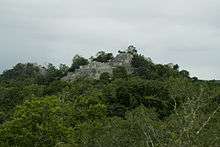Reserva de la Biósfera Calakmul
The Reserva de la Biósfera de Calakmul is in the state of Campeche in the Yucatán Peninsula. With more than 720,000 hectares under protection, it is Mexico's largest intact tropical forest.
Indigienous peoples who live in and around the reserve are involved in agriculture, raising cattle, forestry, and the harvest of chiclet gum. Principal crops include maize, beans, calabaza, and chile peppers. Farmers also raise bees for honey, and the honey from this region is especially prized.
Understand
Most of the biodiversity of Earth is in the tropics, and the purpose of the reserve is to conserve an entire ecosystem of jungle and tropical forest. Calakmul has a huge variety of species: around 250 species of trees, 500 species of butterflies, more than 30 species of amphibians, more than 100 species of reptiles, more than 280 species of birds, and more than 100 of mammals. Approximately half of these species are endangered or threatened to a degree that the require environmental protection.

The reserve is threatened by loss of habitat, loss of biodiversity, and population growth in the region around the reserve. Other problems include illegal trafficking in tropical woods and forest resources, fires associated with agricultural activities, and introduction of invasive species. One of the biological consequences of Route 186 has been a tendency to interrupt genetic flow within the reserve, isolating populations north and south of the highway.

History
Landscape
Flora and fauna
Species in danger of extinction include the saraguato monkey, the spider monkey, viejo de monte, ocelot, tigrillo, jaguar, tapir, pato real, zopilote rey, and two species of eagle. Threatened species include a half dozen mammals, such as el puercoesp�n, gris�n, jaguarundi, oso hormiguero; two dozen birds such as the Tucan, the green Parrot, the Yucatan Parrot, the loro ramonero (loro means parrot, but I'm not sure what this one is?), hocofais�n y varias especies de aves rapaces; algunos reptiles, como la salamanquesa, boa, y varias especies de snakes; y algunas plantas como el chech�n blanco, guayac�n negro y el granadillo.
Climate
The reserve has a moist climate with rains in summer. Temperatures average 24–28°C (75–83°F). Annual precipitation is 1000–1500 mm (40–60 inches).
Get in
Nearby towns include Zoh Laguna and Xpujil. The southern Yucatan is traversed by a well-maintained, paved highway, Mexico's Federal Route 186, but most roads in the reserve itself are seasonal tracks, passable only in the dry season and with a proper vehicle.
Fees and permits
Get around
See
One of the most impressive Maya sites in Yucatan, the second highest pyramid after El Mirador (Guatemala). Very nice ruins in the jungle. Monkeys, deers, and other animals can be seen. An under-rated site to be discovered. The only problem is the lack of accommodation. If you don't bring a tent, the closest accommodation is about 50 km away.
Bring tons of repellent: mosquitoes are very aggressive there.
Do
- Ka´an Expeditions, Ejido Valentín Gómez Farías (5km west of Xpujil), ☎ +52 5554515793, +52 9831196512. 24/7. Day tours and camping tours to the Calakmul archaeological site and biosphere reserve. Certified bilingual nature guide. Small and personalized groups only.
Buy
Eat
Drink
Sleep
Lodging
Camping
Backcountry
Stay safe
Go next